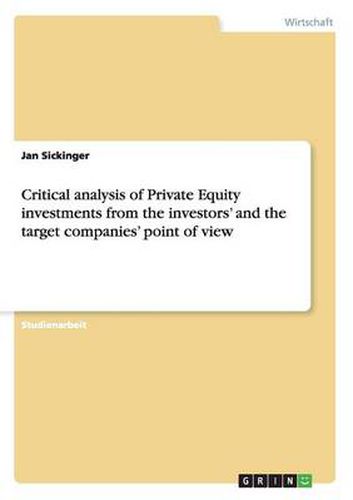Readings Newsletter
Become a Readings Member to make your shopping experience even easier.
Sign in or sign up for free!
You’re not far away from qualifying for FREE standard shipping within Australia
You’ve qualified for FREE standard shipping within Australia
The cart is loading…






Studienarbeit aus dem Jahr 2010 im Fachbereich BWL - Investition und Finanzierung, Note: 2,7, FOM Essen, Hochschule fur Oekonomie & Management gemeinnutzige GmbH, Hochschulleitung Essen fruher Fachhochschule, Veranstaltung: Investment and Controlling, Sprache: Deutsch, Abstract: This assignment is part of the MBA studies at the University of Applied Science in Essen (FOM, Hochschule fur Oekonomie, Essen) and covers the subject International Finance and Controlling . The objective of this assignment was a critical analysis of Private Equity (PE) investments both from the perspectives of PE investors and of PE target companies. PE investors expect high returns, but it could be shown by taking independent data into account that it is highly questionable if the returns of PE investments are always higher compared to other forms of investments. Furthermore, there is the risk of a total loss, which is higher for PE investments than other forms of investments, especially due to the information asymmetry between PE investors and PE issuers. Looking at it from the perspective of PE issuers, PE investments inject fresh capital into target companies with often a high percentage of debts. This capital can be used for expansion and innovation. However, PE investors expect high returns and may use assets of the target company to refinance debts which have been taken in order to finance the PE investment. Furthermore, PE companies will gain managerial control within the target company through which decisions are aligned with the objectives of the PE investor. This can also include decisions regarding the future employment situation in the target company. There cannot be an overall statement if PE investments are good or bad for both sides, because the outcome of an evaluation strongly depends on the statistical method, the observed time span, the choice of statistical data and the personal viewpoint.
$9.00 standard shipping within Australia
FREE standard shipping within Australia for orders over $100.00
Express & International shipping calculated at checkout
Studienarbeit aus dem Jahr 2010 im Fachbereich BWL - Investition und Finanzierung, Note: 2,7, FOM Essen, Hochschule fur Oekonomie & Management gemeinnutzige GmbH, Hochschulleitung Essen fruher Fachhochschule, Veranstaltung: Investment and Controlling, Sprache: Deutsch, Abstract: This assignment is part of the MBA studies at the University of Applied Science in Essen (FOM, Hochschule fur Oekonomie, Essen) and covers the subject International Finance and Controlling . The objective of this assignment was a critical analysis of Private Equity (PE) investments both from the perspectives of PE investors and of PE target companies. PE investors expect high returns, but it could be shown by taking independent data into account that it is highly questionable if the returns of PE investments are always higher compared to other forms of investments. Furthermore, there is the risk of a total loss, which is higher for PE investments than other forms of investments, especially due to the information asymmetry between PE investors and PE issuers. Looking at it from the perspective of PE issuers, PE investments inject fresh capital into target companies with often a high percentage of debts. This capital can be used for expansion and innovation. However, PE investors expect high returns and may use assets of the target company to refinance debts which have been taken in order to finance the PE investment. Furthermore, PE companies will gain managerial control within the target company through which decisions are aligned with the objectives of the PE investor. This can also include decisions regarding the future employment situation in the target company. There cannot be an overall statement if PE investments are good or bad for both sides, because the outcome of an evaluation strongly depends on the statistical method, the observed time span, the choice of statistical data and the personal viewpoint.